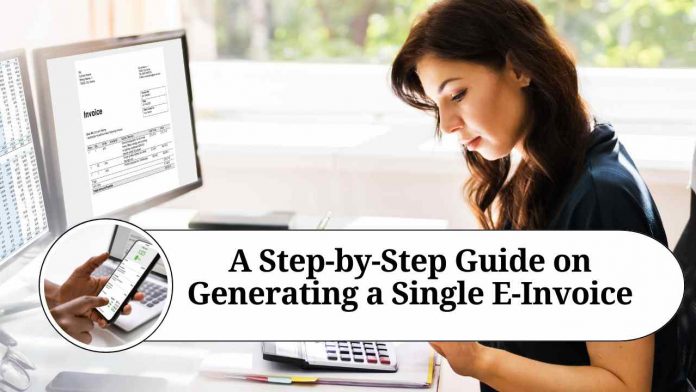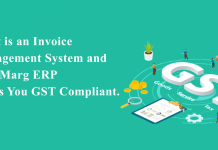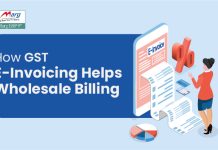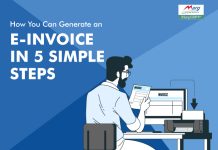Recent Updates on e-Invoicing:
10th May 2023
The Central Board of Indirect Taxes and Customs (CBIC) has announced the implementation of the 6th phase of e-invoicing in alignment with the government’s goal of fostering a digital economy. Effective from August 1st, 2023, businesses that have had an annual turnover of ?5 crore or above since the fiscal year 2017-18 will be required to generate electronic invoices (e-invoices).
Introduction
In recent years, electronic invoicing (e-invoicing) has gained popularity as a more efficient and sustainable alternative to traditional paper-based invoicing. E-invoicing streamlines the invoicing process, reduces errors, and enhances overall productivity. In this blog post, we will walk you through the step-by-step process of generating a single e-invoice, ensuring accurate record-keeping and a smoother transaction experience.
Step 1: Choose an E-Invoicing Platform or Software
To begin, select a reliable e-invoicing platform or software that suits your business needs. Look for a solution that offers compliance with local e-invoicing regulations and supports the necessary invoice formats. There are numerous options available, both free and paid, so conduct thorough research before making your decision.
Step 2: Gather Relevant Invoice Information
Before generating an e-invoice, collect all the necessary details required for the invoice. This typically includes the following:
Invoice number: A unique identification number for each invoice.
Invoice date: The date when the invoice is issued.
Seller information: Your business name, address, contact details, and tax registration number.
Buyer information: The buyer’s name, address, contact details, and tax registration number.
Description of goods or services: Provide a clear and concise description of the products or services being invoiced.
Quantity and unit price: Specify the quantity of items or hours of service provided, along with the unit price.
Tax details: Include applicable taxes, such as VAT or sales tax, and their respective rates.
Total amount due: Calculate the total amount owed by the buyer, including any applicable taxes.
Step 3: Create the Invoice Heading
The invoice heading serves as the primary identifier of the e-invoice. It typically contains essential information such as your company name, logo, and contact details. Follow these guidelines to create an effective invoice heading:
Company name: Place your business name prominently at the top of the invoice.
Logo: Include your company logo for brand recognition and professionalism.
Contact details: Provide your company’s contact information, including phone number, email address, and website.
Address: Display your business address, which can be the physical location or a mailing address.
Step 4: Input Invoice Information in the E-Invoicing Software
Using the chosen e-invoicing platform or software, input the gathered invoice information into the system. Most e-invoicing solutions provide intuitive interfaces for entering data. Ensure the accuracy of each detail before proceeding.
Step 5: Review and Validate the Invoice
Before generating the final e-invoice, carefully review all the information entered to ensure accuracy and compliance. Double-check the invoice number, dates, item descriptions, and tax calculations. Some e-invoicing software may automatically validate the entered data, highlighting any errors or inconsistencies.
Step 6: Generate the E-Invoice
Once you’ve reviewed and validated the invoice, proceed to generate the e-invoice. The e-invoicing platform or software will typically have a button or option to generate the invoice based on the provided information. Click on this option to create the final e-invoice document.
Step 7: Save and Share the E-Invoice
After generating the e-invoice, save it in a suitable format, such as PDF or XML, depending on the requirements of your business or the recipient. Additionally, most e-invoicing platforms allow you to share the invoice directly with the buyer via email or by uploading it to a designated portal.
Conclusion
Generating a single e-invoice can significantly streamline your invoicing process, leading to increased efficiency and reduced paperwork. By following the step-by-step guide provided in this blog post, you can ensure accurate record-keeping, comply with e-invoicing regulations, and enhance your overall transaction experience. Embrace the digital transformation and reap the benefits of e-invoicing for your business.
Read more useful content:
Frequently Asked Questions (FAQs)
Q. What is an e-invoice?
An e-invoice is a digital version of a traditional paper invoice. It is generated, transmitted, and stored electronically, eliminating the need for physical paper documents.
Q. Why should I generate e-invoices instead of paper invoices?
Generating e-invoices offers several benefits, including improved efficiency, reduced errors, cost savings, faster processing times, enhanced record-keeping, and environmental sustainability.
Q. Do I need special software to generate e-invoices?
Yes, you will need e-invoicing software or an e-invoicing platform to generate e-invoices. There are various software options available, both free and paid, that offer features specifically designed for creating and managing e-invoices.
Q. Are there any legal requirements or standards for e-invoicing?
Yes, different countries have their own legal requirements and standards for e-invoicing. It is essential to ensure compliance with the specific regulations of your country or region when generating e-invoices.
Q. What information should be included in a single e-invoice?
A single e-invoice should contain important details such as the invoice number, invoice date, seller information (including name, address, and tax registration number), buyer information, description of goods or services, quantity, unit price, tax details, and total amount due.
Q. How do I create an effective invoice heading for my e-invoice?
An effective invoice heading should include your company name, logo, contact details (phone number, email address, website), and address. It helps to create a professional and recognizable identity for your business.
Q. Can I customize the layout and design of my e-invoice?
Yes, most e-invoicing software allows you to customize the layout and design of your e-invoice. You can often personalize elements such as colors, fonts, and placement of your company logo.
Q. How can I ensure the accuracy of the information in my e-invoice?
It is crucial to double-check all the information entered in your e-invoice before generating it. Review the invoice number, dates, item descriptions, tax calculations, and buyer/seller details for accuracy and consistency.
Q. Can I save and share my e-invoice in different formats?
Yes, e-invoicing software usually provides options to save your e-invoice in various formats such as PDF, XML, or other standardized formats. These formats ensure compatibility with different systems and facilitate easy sharing with buyers.
Q. How can I securely share my e-invoice with the buyer?
Most e-invoicing software allows you to securely share your e-invoice with the buyer. You can typically send the invoice directly via email or upload it to a designated portal for the recipient to access and download.




















